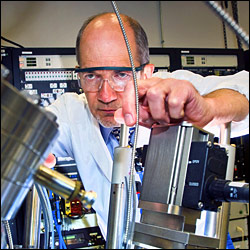Brookhaven National Laboratory scientists are employing an atom-by-atom layering method to develop a thin superconducting field effect device. The technique will help study various conditions that convert insulating materials into superconducting devices.
This scientific advancement may lead to better understanding of high-temperature superconductivity and could speed up the development of resistance-free electronic equipment.
 Exploring the Superconducting Transition in Ultra Thin Films
Exploring the Superconducting Transition in Ultra Thin Films
Ivan Bozovic, physicist at Brookhaven Lab, explained that in modern physics, identifying the exact happenings of transition from the insulating state to the superconducting state in a copper-oxide (cuprate) material is still a great secret. One way of identifying the change is through application of a peripheral electric field to decrease or increase the doping level and by observing the field impact on the current carrying ability of the material. To carry out this process in copper-oxide superconductors, very thin films with uniform composition are required.
Molecular beam epitaxy (MBE) is a technique used by Bozovic-led team for developing superconducting thin films. The technique creates one atomic layer of thin film at a time and has exact control over the thickness of each layer. Researchers have revealed that in thin films produced using MBE technique; every single layer has the potential to exhibit high-temperature superconductivity.
Researchers have applied the same MBE method to develop ultrathin field effect devices that are same like field-effect transistors (FETs). In order to withstand high electric fields for stimulating superconductivity in the cuprate materials, an enhanced field effect device was created. The temperature of lanthanum-strontium-copper-oxide superconductor prototype in the device can be tuned to a maximum of 30°K, which is 10 times greater than the earlier record. This improved field effect device is currently being used by the researchers to study a few basics of high-temperature superconductivity.
One of the important findings from the study is that the insulating copper-oxide film shifts to superconducting state when the resistance of the film sheet reaches 6.45 kW, which is equal to the value of Planck quantum constant (h) divided by twice the electron charge (e) squared. Another amazing point has been discovered from the study. For several years, it has been known that pairing of electrons take place in the superconducting state. But, the result shows that even in the insulating stage of copper-oxide, electrons form pairs.
Superconducting FETs could offer potential applications and therefore the creation of thin films is more beneficial as they improve the capability to manage the superconductivity via an external electric field. The research by Bozovic and his team will further advance the study on high-temperature superconductors.